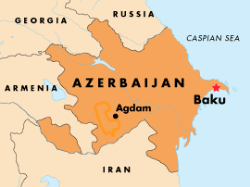Part of the optimism stems from growing international attention to the problems of the post-Soviet states.
The decision of the United States to press for the inclusion of the frozen conflicts in Nagorno-Karabakh, Abkhazia, South Ossetia, and Transdniester on the St. Petersburg G8 summit agenda is a case in point.
Armenia's foreign minister said that if Azerbaijan accepts the right of the people of Nagorno-Karabakh to self-determination to be exercised at some time in the future, Armenia is prepared to move on other issues.
International politics appears to be shifting, and energy seems to be at the heart of the matter -- energy combined with the increasingly robust foreign policies of Russia and Iran.
As a major oil and gas exporter and a neighbor of Iran, Azerbaijan increasingly finds itself the focus of U.S. attention. With U.S.-Iranian relations continuing to worsen, few doubt that Iran and the possibility of sanctions will be on the agenda when Azerbaijani President Ilham Aliyev meets with U.S. President George Bush in Washington on April 28.
Azerbaijan's Position
But Aliyev may feel emboldened to ask for more in return. Brenda Shaffer, who is head of the Caspian Studies Department at the University of Harvard, thinks this is a good moment for Azerbaijan to link wider international concerns to the problem of Nagorno-Karabakh.
"If there will be any sanctions regime on Iran and it's very clear that in any economic sanctions it will be very important the border with Azerbaijan [sic]," Shaffer said. "Clearly this will be on the agenda between Bush and President Aliyev and this will be the place for President Aliyev to say: OK, we're cooperating on international issues in such a way, we need international cooperation and fulfillment on Nagorno-Karabakh. I think there will be a good chance to make progress through this meeting."
This comes at a time too of growing fluidity in talks between the Azerbaijanis and Armenians. As Steven Mann, Washington's chief Karabakh negotiator, left Yerevan and traveled on to Baku, Armenian Foreign Minister Vartan Oskanian said that if Azerbaijan accepts the right of the people of Nagorno-Karabakh to self-determination to be exercised at some time in the future, Armenia is prepared to move on such issues as Azerbaijani territories outside Karabakh occupied by Armenia, the return of refugees, and security guarantees.
That provoked an unusually rapid and positive response from Azerbaijan. Oskanian's comments, it said, were constructive and demonstrated a commitment to actively take part in peace talks on the resolution of the Armenian-Azerbaijani conflict.
A Topic For The G8 Agenda
Shaffer believes the U.S. call to include the frozen conflicts on the agenda of the G8 summit strengthens Baku's hand even more.
"The idea that this will on the table during the G8 meetings in St Petersburg in July is an incredible opportunity for Azerbaijan and probably the Azerbaijani leadership is focusing on how, with all these geopolitical changes taking place, how to keep Nagorno-Karabakh on the international agenda and how to use these geopolitical changes in order to benefit the Azerbaijani stance on the Nagorno-Karabakh conflict," Shaffer said.
The OSCE, which is mediating the peace talks, will also want to exploit the new fluidity in international politics. Ideally, it would like another summit to follow the disappointing meeting between Aliyev and Kocharian in February. But Yuriy Merzlyakov, who is Moscow's OSCE negotiator, is calling for patience.
"I think it would be premature to talk of an agreement," Merzlyakov said. "We need to talk first to the ministers and we need to visit the region again. I think it would be desirable to wait until mid-May."
But it is not just Nagorno-Karabakh where there is sign of movement.
The European Union -- which until recently has seemed too focused on its problems in the Balkans to contemplate the challenges of the Southern Caucasus and Moldova -- may be changing its position. The German paper "Der Welt" writes today that Chancellor Angela Merkel is planning to use a speech to the European Union parliament in early May to urge the development of a new eastern policy for Europe, which would put the Caucasus at the center of its focus.
And it may not be alone. Washington too appears to be taking greater interest -- prompted perhaps by the need to protect its energy interests in the southern Caucasus and Russia's increasingly muscular assertion of its power in the region.
On 4 May, U.S. Vice President Dick Cheney is expected to confer unexpected significance on a meeting of the leaders of Black Sea and Baltic states by traveling to Vilnius to address their conference on the problems of the region.
The Nagorno-Karabakh Conflict
 Click on the image to view an enlarged map of the Nagorno-Karabakh conflict zone
Click on the image to view an enlarged map of the Nagorno-Karabakh conflict zone
In February 1988, the local assembly in Stepanakert, the local capital of the Azerbaijani region of NAGORNO-KARABAKH, passed a resolution calling for unification of the predominantly ethnic-Armenian region with Armenia. There were reports of violence against local Azeris, followed by attacks against Armenians in the Azerbaijani city of Sumgait. In 1991-92, Azerbaijani forces launched an offensive against separatist forces in Nagorno-Karabakh, but the Armenians counterattacked and by 1993-94 had seized almost all of the region, as well as vast areas around it. About 600,000 Azeris were displaced and as many as 25,000 people were killed before a Russian-brokered cease-fire was imposed in May 1994.
CHRONOLOGY: For an annotated timeline of the fighting around Nagorno-Karabakh in 1988-94 and the long search for a permanent settlement to the conflict, click here.
 Click on the icon to view images of the Nagorno-Karabakh conflict (Flash required)
Click on the icon to view images of the Nagorno-Karabakh conflict (Flash required)
To view an archive of all of RFE/RL's coverage of Nagorno-Karabakh, click here.













